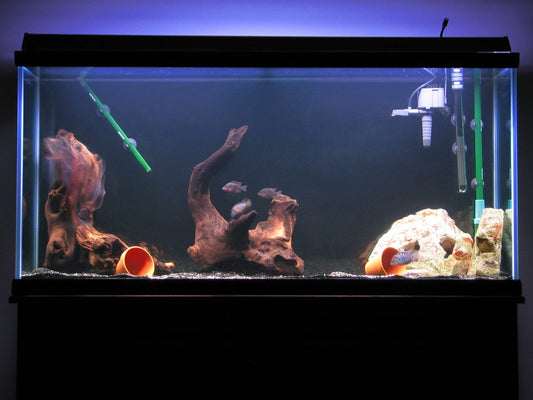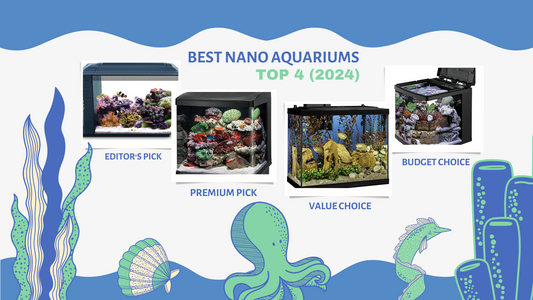Aquariums 101: Breeding Fish for Beginners

Are you interested in learning how you can start breeding fish in an aquarium? It’s not as difficult as you may think! In this article, we’ll go over the basics of tropical fish breeding in captivity. Breeding colorful fish in freshwater aquariums is an exciting aspect of the aquarium hobby.
We’ll cover everything from selecting the right species of freshwater fish to raising the fry. By the end of this guide, you’ll be an expert on tropical aquarium fish breeding!
Breeding Aquarium Fish: An Overview
There are many potential benefits of raising fish in your home aquarium. It provides a renewable source of the species you like, which can save money on purchasing new adult fish. You’ll also enjoy the process itself – watching your baby fish grow and reproduce is incredibly rewarding!
Before diving into breeding fish, it’s important to consider which fish to breed. Some fish are very easy to breed, while other fish can be more difficult – especially those that lay eggs. You’ll also need to consider the size of your aquarium and the space available for fry once they hatch.
When it’s time to breed your fish, you can use various methods such as conditioning them with higher-protein foods or manipulating the light cycle. If all goes well, you’ll soon have eggs or pregnant livebearer fish in your aquarium.
Raising the fry can be a challenge, as they require very small food sources and stable water conditions. You’ll also need to watch out for predators such as larger fish or snails.
While it may seem overwhelming, this guide will walk you through the basic mating process for many fish breeds that you’ll find in a community aquarium. Our hope is that this will provide a basic overview on the breeding of particular species in your fish tank.

Choosing the Right Fish Species
When it comes to choosing a species for your aquarium, livebearer fish are a great option. They’re relatively easy to breed and can reproduce healthy offspring quite quickly. Common livebearing species include guppies, mollies, platies, and swordtails. They are also available in a wide variety of colors, shapes, and sizes.
Livebearers can be found at most local fish stores, so you won’t have to worry about finding them. They are generally easy to keep in a community tank environment and can spawn often with minimal effort on your part given their breeding habits. For example, to breed guppies you need to do little more than feed them high protein foods in a warm tank with hiding places, and given their easy spawning methods you’ll have newly hatched fry in no time.
Taking it to the Next Level
If you’re looking for something a bit more challenging, there are many other species to choose from. Many of the smaller tetras and rasboras can be bred in captivity, as well as some of the larger cichlids. It’s important to know which species lay eggs, which create bubble nests, what fry foods might be necessary, or if you may need an outdoor ponds, special tanks, or breeding setups, so researching the fish species you plan to breed is important.
Setting up the Breeding Tank
Regardless of which species you decide to breed, it’s essential to set up a separate breeding tank.
First and foremost, the breeding or spawning tank should provide your adult fish with a safe environment for spawning and rearing their fry. This means decorating the aquarium with plenty of hiding places, such as rocks and live plants. The water parameters need to be kept stable, as fluctuations can cause stress in both adults and fry.
A breeding tank also allows you to monitor and intervene if needed. You can provide food for the fry as soon as they hatch, and help them adjust to life in the aquarium. This is especially important with some of the more difficult species that may require special care during their early developmental stages.
Finally, once the breeding process is over, you can also use the breeding tank to isolate sick or injured fish, preventing them from spreading their diseases to other aquarium inhabitants. I often use my quarantine, hospital, and breeding tanks interchangeably.
Tank Setup To Breed Fish
Proper filtration, water quality, and tank size are all essential components of a proper breeding setup. With the right environment, you can ensure that your fish will have the best chance at reproducing and raising healthy fry. The goal here is to have your fish in the best position possible to produce healthy offspring (and if you can sell fish to a fish store on the other side – that’s a bonus!).
Providing hiding places and nesting sites for fish in a breeding tank is an important aspect of creating the right environment for them. Hiding places can provide security from predators and other stressors, while also providing safe spots to rest. Nesting sites are necessary for spawning fish that need more specific conditions to lay their eggs.
Nesting sites for fish that spawn should be secluded and well-shaded, as some fish are sensitive to light levels during their nesting period. Spawning mops, clay pots, or other structures specifically designed for nesting can provide ideal conditions and give the fish a secure location to lay their eggs. It’s also important to make sure the substrate of the tank is appropriate for the species, as some fish may require a specific type of gravel or sand like egg layers.
Providing these types of hiding places and nesting sites can create a more natural environment for breeding fish and can help ensure they remain healthy and produce successful spawns. It’s an important factor to consider when setting up a breeding tank.
Most species of livebearers will also appreciate nesting spots. They can get away from the view outside of the aquarium, and some species will feel more secure when hidden.
Water Conditions for Breeding Fish
In addition to providing the right types of hiding places for breeding fish, it’s also important to create and maintain an optimal water environment. The temperature, pH, and hardness of the water will all affect a fish’s ability to reproduce successfully.
Most aquarium fish require a temperature range between 72 and 83 degrees Fahrenheit (22 and 28 degrees Celsius). This can vary slightly depending on the species of fish, so it’s important to research the specific needs of your chosen freshwater fish.
By maintaining the proper temperature, pH and water hardness, you can create an environment that encourages successful reproduction in many species of fish. It’s also important to check for any contaminants or pollutants that may be present in the water, as these can be harmful to your fish.
Creating the right environment is essential for successful breeding and raising healthy fry. By providing hiding places, nesting sites, and the correct water conditions, you’ll give your fish the best chance of having a successful spawn. With a little bit of research and effort, you can create the ideal environment for your fish and help ensure their success.

The Best Diet for Breeding Fish in Your Aquarium
In addition to the right environment, providing the appropriate diet for your breeding fish is an important component of successful reproduction. High-quality food, such as high protein food and live foods are essential components of a successful breeding setup.
Providing high-quality food will help ensure that your eggs and fry have the nutrients they need for optimum health and reproductive success. Live foods, such as brine shrimp, daphnia and mosquito larvae are all good sources of protein for breeding fish. These can also provide important vitamins and minerals that will help ensure healthy fry.
You can find many of the proper foods at fish stores where you’ll likely also find helpful advice regarding which fish to breed that are in stock, who is likely to be a parent fish, or maybe a species of fish that has already laid it’s own eggs!
Monitoring the Breeding Process
To ensure a successful spawning, it is necessary to frequently observe your fish. Examining the baby fish or eggs and keeping an eye out for any anomalies in both water quality and breeding behavior of the pair are essential aspects of monitoring their progress.
It’s also important to check the water conditions in your tank regularly. PH and temperature fluctuations can affect the fish’s ability to spawn, so it’s important to monitor these parameters to ensure they remain stable. Most fish in a nursery tank will be extremely susceptible to disease, so this is very important.
Aquarists should watch to see how their freshwater fish are interacting and observe any changes in their behavior. Pay close attention to how the fish behave with each other and look out for signs of aggression or stress.
For most female fish, you’ll be able to see their size increase as their eggs develop. This is a good indicator that the female is ready to spawn and can help you keep track of the process. By knowing when a fix is pregnant, you’ll be better prepared to separate the fry from the parent fish when necessary, whether in a separate tank or breeding box.
Removing the parents from the tank and other fish once the eggs hatch or fry are born is often vitally important, to prevent them from being eaten. Additionally, this will help ensure the fry receive enough food and oxygen and are not exposed to any predators.

How To Care for the Fry
Caring for newborn fish is one of the most important parts of successfully learning how to breed fish in a freshwater tank. This includes making sure they are properly fed, regularly checking for diseases and parasites, and maintaining a healthy environment.
The fry should be fed small, nutritious food that is easy for them to swallow. Live foods, such as baby brine shrimp and daphnia, are a great option for fry. You can also supplement their diet with commercial foods designed specifically for baby fish. Guppy fry and other young fish are quite small, and therefore need to be fed high protein diets that can fit in their tiny mouths. Crushed flakes likely aren’t going to be a suitable option in this scenario.
Finally, check your fry for any signs of illness or parasites. If you notice any concerning symptoms, separate the sick fish and treat them with the appropriate medication as soon as possible.

Common Challenges
Caring for fry can be a challenging task and there are several common challenges that aquarists may face.
Overcrowding can be a major issue, as too many fry can compete for resources and make it difficult to keep the tank clean. It is important to monitor your tank regularly to make sure it does not become overcrowded.
Finally, it is important to monitor the tank’s water parameters on a regular basis as any changes can be stressful for fry and cause them illness or injury. Stable temperatures and pH levels are essential for keeping healthy aquarium inhabitants, especially smaller fish like fry.
Conclusion
Fish breeding in an aquarium can be a rewarding experience and the steps involved are not overly complicated. Before attempting to breed fish, it is important to do in-depth research about the fish to breed, selecting the right breeding pair, whether they are egg scattering or live bearers, and other basic information to make sure you have chosen the perfect fish.
By following the steps laid out in this guide, you’ll give yourself the best chance of success when trying to breed fish in your aquarium.
No comments






comments